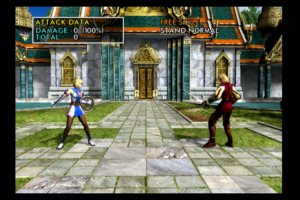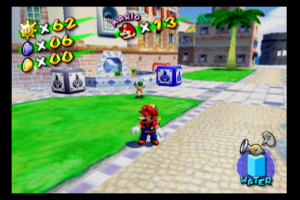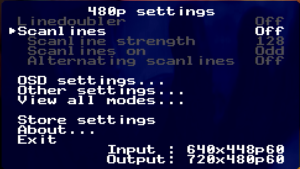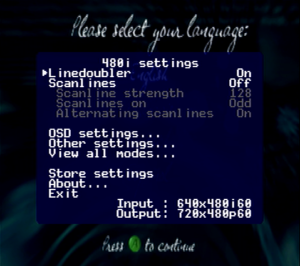Disclaimer – We supply a fitting service for this part, so obviously it’s in our interests to give it a great review. However, we’ve been as objective as possible and have not hidden any faults or problems we found while testing.
25/07/18 – After all this time we finally have a working board! Thanks to Dan Kunz/Black Dog Technology for the super duper GCDual.
14/11/16 – Our new version of the mod has been severely delayed while we investigate seemingly random picture noise issues.
25/03/16 – We will soon be launching a new version of this mod. The new mod features identical software, but a much neater fitting, see this page for more information.
01/02/16 – Another important update – One of our customers reports that the enhanced DVI mode does not work on the Sony KDL-40HX800 TV.
11/12/15 – Important update – Unseen has released a new firmware that fixes the problems we had when using the HDMI Gamecube on our Sony TVs.
If you want to see a video of this mod in action, click here. I’ve also taken some comparison screenshots that you can view here.
While we all wait with baited breath for the N64 HDMI upgrade, almost out of the blue, another classic Nintendo console has received the HDMI upgrade treatment. Nintendo’s much loved sixth generation Gamecube console existed at that awkward time when EDTV and HDTV was just starting to gain market traction. Like it’s main competitors the Dreamcast, PS2 and Xbox, the Gamecube ended up supporting a hotchpotch of different screen modes and AV cables. If you lived in America or Japan, you could purchase a component video cable and run most games in 480p, while users in Europe were treated as second-rate citizens by Nintendo and only given the choice of either 50hz or 60hz interlace modes. At the time, many gamers were still using 15khz CRT displays and largely ignored the digital video cables that Nintendo sold. Limited sales of the component cables has driven up the price considerably on the second hand market now that such cables and screen modes are highly desirable for modern, progressive displays. Getting the best picture out of the stock Gamecube is a matter of finding the best software and the increasingly rare hardware. Now, thanks to the new Gamecube HDMI mod, it’s easier than ever before to get your Gamecube looking pristine on your new HDTV.
Kicking component to the curb

The Gamecube HDMI mod is the result of the hard work of a skilled modder and engineer who goes by the handle of Unseen. In actual fact, this mod isn’t new, it was first introduced in late 2014 when Unseen announced on the Shmups forums that he had produced a working clone of the Gamecube component cable. Unseen published his work as an open source project on Github here. Since then the project has been improved upon and some fantastic features have been added, going far beyond what would be possible with the standard Gamecube component cable. The version of the mod we’re reviewing here uses a standard FPGA board called the Pluto-IIx XC3S200 HDMI. This board has been flashed with some custom firmware and then installed into our test Gamecube, replacing the old “Digital” port that the component cables use to plug into. The mod is only compatible with Gamecubes that have the digital out port, so be sure to check if you’re buying a second hand console to upgrade. Installation of the mod does require a small cosmetic change to the back of the unit, but of course this cannot be seen when the Cube is in normal use. Once the mod is installed, simply connect your HDMI cables and fire up your Gamecube and you’re instantly treated to a fully digital version of your beloved classic console. Since the FPGA board doesn’t include a frame buffer, the Gamecube’s video is output in real time, with no additional input lag.
Gamecube plus
While you might be content to simply have a HDMI Gamecube, the mod goes further than just a simple analogue to digital conversion. By pressing and holding the L, R, Y and X buttons on the Gamecubes controller, you can access a configuration menu that has several interesting and useful settings. The picture below shows the settings for a 480p Gamecube game.
The Gamecube supports 240p, 480i and 480p (and PAL versions of those resolutions). The Gamecube HDMI mod supports all of these resolutions. 240p is automatically line doubled (since HDMI isn’t usually compatible with 240p). You can also add scanlines to any resolution, allowing you to add that retro look and feel to 480p games or simply re-introduce the scanline look on a 240p title. Scanlines work great with the Gamecube player, for instance. While Gamecube games never actually had scanlines, they all run in low resolution and are a natural fit for a scanline overlay.
Things get even more interesting when we move to a 480i game.
Notice the “Linedoubler” option is available for 480i games. This can be a huge advantage on modern displays. As you might be aware, feeding a 480i signal to a modern HDTV means that the image must be deinterlaced. Deinterlacing is a complex subject and there are lots of ways to go about it. Unfortunately for gamers, good quality deinterlacing introduces input lag. Modern TVs prioritise picture quality over input lag and therefore introduce several frames of lag when deinterlacing an image.

By turning on the Linedoubler function on a 480i game, the Gamecube HDMI will perform a quick deinterlace/line double that introduces no input lag whatsoever. If you’ve used upscalers like the XRGB3 or DVDO Edge that include similar such quick deinterlacing, you might be well aware that the image gains some flicker when in this mode. This is true here too, but the effect isn’t as bad as we anticipated. It certainly depends on your display, with larger displays suffering more, but we found Mario Sunshine to be quite playable in this mode and of course the reduced input lag always helps with tricky platform games. If you prefer you can simply shut the linedouble functon off and let your TV or video processor handle the deinterlacing. There’s always a trade off with interlace content and we’d recommend tracking down US versions of your games where possible, but at least now you have the choice of how to handle the interlaced image. Of course, this also makes the mod compatible with displays that can’t handle 480i at all. You can save scanline, line-doubler and other settings on a per-resolution basis and the HDMI mod will remember your settings the next time you come to play any game in any particular resolution.
Digital audio too
Hidden in the “Other Settings” option on the OSD menu is a function labelled “Enhanced DVI Mode”. Turn this setting ON, and the mod will route the Gamecube’s audio through the HDMI cable too, effectively making this mod a digital audio mod too. We tested this functionality with several games and found it worked flawlessly with each one. Even CD audio, such as that used in games like Eternal Darkness, worked perfectly. Unfortunately it seems that enhanced DVI mode doesn’t work with all displays. A small number of TVs we tested, namely the Sony KDL-40Z4500 and the Sony 32W4000 displayed a strange ripple pattern through the image whenever we used enhanced DVI mode and any progressive scan screen mode. As of December 2015, Unseen has released a new firmware that fixed the problems we had with our prototype Gamecube and our Sony TVs. We can now report 100% compatibility with all televisions we tested. All HDMI Gamecube upgrades that we sell will include this latest firmware. As of February 2016 we’ve had one report of a TV incompatible with enhanced DVI mode on this new firmware – A Sony KDL-40HX800.
If you are unlucky enough to find a display that is incompatible with enhanced DVI mode, you still have options. You can route the Gamecube HDMI signal through a video processor, such as the DVDO Edge, VP50 or XRGB Mini. Alternatively, since the consoles analogue video and audio output is unaffected by the mod, you can simply route the analogue audio directly to an amp or receiver using a standard Gamecube AV cable. Finally, although we didn’t test this option, you can also use a HDMI or DVI audio integrator too. These boxes accept HDMI or DVI input and analogue audio input, and output a combined HDMI plus audio stream to route to your TV.
The ultimate Gamecube upgrade?
Ultimate is a word that’s often abused in the English language, since it actually means “biggest, best and last”. To be completely grammatically correct, you should only apply the label to something if it really is likely to be the last of its kind, since nothing could ever possibly better it. In this instance however, it’s quite difficult to see what could be added to the Gamecube HDMI mod that hasn’t already been included. Perhaps true upscaling to 1080p or 4k? For most people that would simply be unnecessary since modern TVs already do a good job with 480p content anyway. Being able to linedouble 240p and 480i games and add scanlines means there’s little need to run your cube through an XRGB Mini or similar scaling device. What’s more, unlike the increasingly difficult to find Gamecube component cables, this mod is available now. For those of you confident with DIY, check the links here and here to get started programming and installing your own FPGA board. If you prefer someone else to handle the fitting and installation, our fitting/upgrade service is now available here. However, this is a complex mod to fit, so unfortunately it isn’t cheap, the price to supply the FPGA board, install and test the mod will be £167. Turnaround time is expected to be 3 to 4 weeks. While this is a little expensive, keep in mind that Gamecube component cables often retail on eBay from £80 to anywhere upwards of £240 plus shipping. As explained in the review, you’re also getting a mod that performs significantly better than the Gamecube component cables do on their own. While the cost may put some off, the Gamecube HDMI mod really does deliver a fantastic upgrade for your classic Nintendo console. If you love Nintendo’s diminutive little cube, this is the upgrade you need to bring it into the modern age. The HDMI mod delivers the absolute best performance from the original Gamecube hardware, another fantastic achievement by the retro-gaming community.




How much longer?
So I would like to buy one of the boards with the software installed if possible? Is that something you do? In the Uk and i imagine shipping would just make the cost too great to purchase a whole cube, id rather mod it myself but cant find these hdmi boards anywhere.
Not presently, sorry.
Any word on when we might see more of these available?
Sorry no, we got a whole new board in but it’s having problems too.
Will the hdmi gamecube mod be back in stock when you have fixed the new version of the mod?
what is the different’s between this one and the new version?
Yes, when that will be though, I do not know.
wow it’s been almost 4month from when i put this post in. it fells like a month ago.
I own a Wii with component cables which are inexpensive and it plays Gamecube games at a very nice revolution. I know how annoying it is to have to plug the controllers into the top of the Wii along with the memory cards but it is worth it and is one of the cheapest ways to get great quality out of a Gamecube game.If you do have the money to buy the component cables for the Gamecube, it is significantly better than the Wii. if you have the electronic skills to mod the Gamecube with the chip, that is the best quality available.
The general consensus seems to be that the picture is a tiny bit better on Gamecube component vs Wii, yes.
I’m assuming this modification would work on the Panasonic Q as well? I believe the internal hardware are the same with the presence of the digital av out, aside from small additions for DVD playback and an optical audio pcb.
It might, we’ve never tried, do you really want to cut into a super rare Panasonic Q?
Well I’ve already placed a region swap toggle on the back of the system that allows me to play both US and JPN region games, so yeah it wouldn’t bother me as long as cosmetics are good (and of course the modification works well).
Should have used our region free mod, no cosmetic changes necessary for that 🙂
Okay so I looked into this for you and the problem is we don’t have a Panasonic Q, or anyone willing to have theirs modded, so we really don’t know if the board would fit I’m afraid.
If you could give me the ROM Board and component board model numbers of any GCN you have/are working on, I can compare it with the Q and let you know if it’s feasible.
167£? OMFG!
New version is significantly cheaper than that.
Hi team, any idea when youre going to start accepting orders for the hdmi mod again?
I did this mod myself, and I could not be happier with it. Because my GameCube has a Wasp Fusion rather than a disc drive, I was able to utilise the extra space inside to install an HDMI passthrough cable that attaches to the FPGA board and then feed to the back of the console where I cut a hole just big enough for an HDMI port and screwed it in. Looks very neat, if I do say so myself.
Since this service isn’t available (found out about this mod a week or two after), I decided to order all of the components and try my hand at it, and i got all the parts the other day. The one thing I saw on the github files were that you needed a 100 ohm resistor, (this is going to be a really noobish question) but I wasn’t sure how to solder both the resister and the 5V to the same pin. Do you put the resistor in first and then attach the 5V wire to the underneath of the resistor on the UNREG pin of the pluto? This is my first time doing a mod like this before lol.
You only need have waited a couple of weeks, we’ll have a new, much neater mod. As for your question I’ll have to ask Dan.
Okay, apparently.. “Yes exactly, fit the resistor first, push the leg right through, then fit the 5v wire the the resistor leg on the other side of the board. (You can trim the leg shorter if required, and snip off the other leg close to the board.) Use some heatshrink to cover the exposed leg and the join to the 5v wire.”
Hope that helps. If you need more tech support the forum thread here is useful – http://shmups.system11.org/viewtopic.php?f=6&t=51450
Fucking snake oil salesman, you lot are. I’ll do the mod for free, for whoever. These prices are outrageous for gamers. Seriously, I’ll mod people’s shit in my spare time at their own expense. PM me. I’m highly experienced in electronics and based in the USA. Fuck you redcoats.
That’s nice that you can afford to work for free, and buy FPGA boards for free, and pay for free shipping etc. Best of luck to you with that!
Well, considering this is what these people probably do to make money and not on the side, they kinda have to charge, and also, you do realize the board alone costs 60$? Most people don’t have a soldering station, desoldering equipment and all the other tools that would probably cost more for a one time thing then just sending it to someone else who has all the tools and time for labor… maybe the price seems high to you but seeing the high quality job that they do along with keeping in touch via email, doesn’t seem like theres a good reason to hate on them (especially since they helped spread this mod around and made it more accessible)
I’m interested
So this mod also allows you to display the native res of the Gamecube games in a menu (IE that 640*448p in one of your shots.) That’s really cool and interesting actually. I have quite a complex upscaler and would rather have the upscaler deal with all the upscaling. Having the ‘cube go to 480p and then having that 480p upscaled to 1080p or 4k will have more upscaling artifacts than going straight to 1080p/4k from native res.
My question is: can I get the ‘cube to just output at native res or is 480p the only option? Thanks.
The Cube is outputting at native resolution, or what you would get from the component cables. It’s extremely unlikely that an upscaler could do a better job fed a 640*448 signal (likely it wouldn’t even be able to process it).
This is still a very cool product, but just so you understand I’m coming from. When you upscale something, even as perfectly as the XRGB Mini, unless the original resolution fits exactly into the resolution you’re upscaling too, you’re going to get some upscaling artifacts. By upscaling to 480p and then upscaling to 1080p you’re actually doing this twice. 480p does not perfectly fit into 1080p so the upscaling has to product artifacts.
All I’m saying is if you have an image of 640×448, it’ll look slightly better by scaling straight to 1920×1080 rather than first scaling to 720×480 and then going to 1920×1080. In theory (though perhaps not in practice) this method should also be significantly lower lag.
Okay, first of all this mod does not upscale at all. The Gamecubes internal GPU may be rendering at 640*448, but the Gamecube would never output this resolution, no TV supports it. The image is always padded out to 480p. Look at the screenshot again, can you see the black area? That’s where the image is padded out.
Secondly, upscaling itself rarely produces any input lag, it’s picture processing that does this. This has been confirmed with the Leo Bodnar input lag tester. This mod is 100% lag free (well, a few microseconds if you want to be anal), it has no frame buffer so it cannot lag. Any input lag is added by your TV/processor
Upscaling is a complex subject, but people tend to get too hung up on trying to get perfect integer scaling. FBX has created a bunch of profiles for the Mini to that same end, they work pretty well, give them a shot. http://www.firebrandx.com/pixelpurist.html
interested in more information on the ‘fitting service.’ Where will you guys be based out of? Will shipping to America be available, and will you have full units available for purchase rather than sending one in to be fitted?
We’re based in the UK, we can ship to the USA but it can be pricey. Plus you have to watch out for customs charges, there’s really not much we can do about that.
I got a set of component cables for $180 dollars and that was the cheapest I have ever seen them sold on ebay. I might stick with that since I can always plug my GCN to a CRT with component, but man, awesome mod!
If you still need CRT compatibility you can still use the standard AV port, but I believe they disabled RGB on that on US Gamecubes? So yeah if CRT is your target then component cables are probably a better bet, at least with a US cube anyway.
Why would he use composite instead of component? Component allows for 480p (instead of 480i) and proper colors.
Component or RGBHV cable → CRT is still the best way to connect your Gamecube (or Wii) by far imho.
Why would who use composite? Remember many consumer CRTs do not support 480p.
can i use the same games for this or would i need to get updated versions of lets say mario strikers
It’s compatible with all Gamecube software of course. NTSC versions of games are recommended where possible since they usually have the 480p/Progressive scan option.